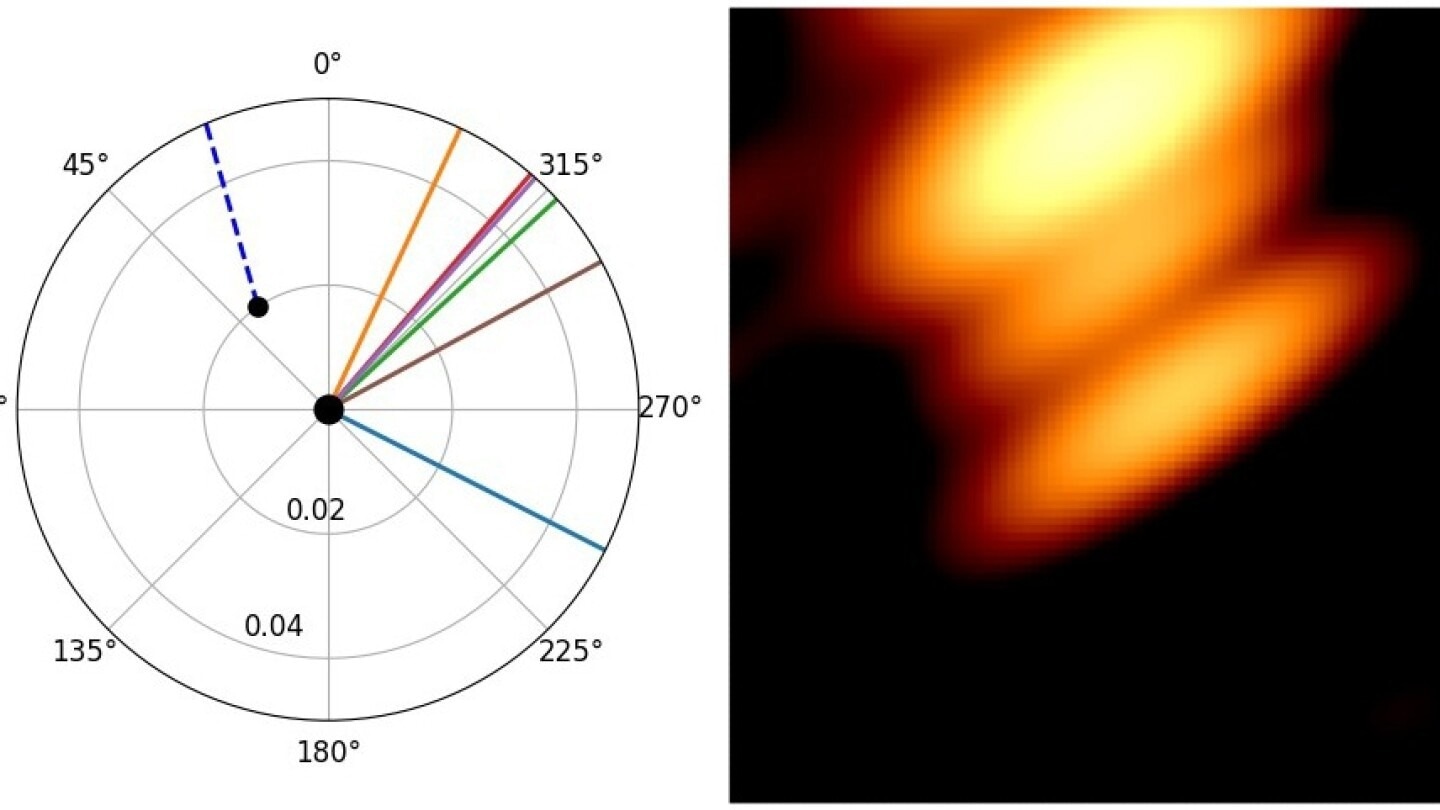A global team of researchers has successfully captured images of two black holes in orbit around one another at the center of a quasar known as OJ287. Quasars are exceptionally luminous galactic cores, with their brightness resulting from a supermassive black hole at the galaxy's center consuming the surrounding cosmic gas and dust. The study was published in the Astrophysical Journal.
 Two black holes in orbit around each other in quasar OJ287. On the left is a theoretical diagram, calculated by Lankeswar Dey, showing where the black holes and the jets emanating from them were at the time when the picture was taken. On the right is part of an image taken by the system including the RadioAstron satellite (J.L. Gomez and et al., 2022), where the two lower bright spots are the radio emission coming from the two black holes, and the topmost spot is the jet of the smaller black hole. This is shown as a dashed line on the left-hand side diagram, while the black holes are shown as dots. Image Credit: University of Turku
Two black holes in orbit around each other in quasar OJ287. On the left is a theoretical diagram, calculated by Lankeswar Dey, showing where the black holes and the jets emanating from them were at the time when the picture was taken. On the right is part of an image taken by the system including the RadioAstron satellite (J.L. Gomez and et al., 2022), where the two lower bright spots are the radio emission coming from the two black holes, and the topmost spot is the jet of the smaller black hole. This is shown as a dashed line on the left-hand side diagram, while the black holes are shown as dots. Image Credit: University of Turku
Previously, astronomers have been able to image the black hole located at the center of the Milky Way, as well as one in a nearby galaxy referred to as Messier 87.
Quasar OJ287 is so bright that it can be detected even by amateur astronomers with private telescopes. What is special about OJ287 is that it has been thought to harbor not one but two black holes circling each other in a twelve-year orbit, which produces an easily recognizable pattern of light variations in the same period.
Mauri Valtonen, Study First Author, University of Turku
Quasar Discovered "By Accident" in the 19th Century
The earliest records of OJ287 can be traced back to the 19th century through old photographs, when astronomers first captured images of the relevant region of the sky. At that time, the existence of black holes was unimaginable, let alone that of quasars. OJ287 was inadvertently included in photographs while astronomers were concentrating on other celestial objects.
Aimo Sillanpää, then a master's student at the University of Turku, observed in 1982 that the brightness of the object exhibited regular fluctuations over a 12-year span. He subsequently pursued research on OJ287 as a university researcher, hypothesizing that the variations in brightness were due to two black holes in mutual orbit.
Numerous astronomers have been diligently observing the quasar to verify this theory and to gain a comprehensive understanding of the orbital dynamics of the black holes.
The enigma of the orbit was ultimately resolved four years ago by Doctoral Researcher Lankeswar Dey from Mumbai, India, who was working part-time at the University of Turku. The only remaining question was whether both black holes could be observed simultaneously.
This question was addressed by NASA's TESS satellite, which detected light emanating from both black holes. Nevertheless, they were still perceived as a single point of light, as images captured with standard light lack the resolution necessary to distinguish the black holes individually. What was required was an image with a resolution 100,000 times greater, achievable through the use of radio telescopes.
Scientists Identified New “Wagging Tail” Jet From the Smaller Black Hole
In the most recent study, astronomers conducted a comparison between previous theoretical calculations and a radio image. The two black holes appeared in the image precisely where they were anticipated to be. This provided the researchers with a resolution to a question that has remained unanswered for 40 years: the existence of black-hole pairs.
For the first time, we managed to get an image of two black holes circling each other. In the image, the black holes are identified by the intense particle jets they emit. The black holes themselves are perfectly black, but they can be detected by these particle jets or by the glowing gas surrounding the hole.
Mauri Valtonen, Study First Author, University of Turku
The researchers have also discovered an entirely new type of jet originating from a black hole. The jet produced by the smaller black hole resembles the twisting motion of a rotating garden hose. This phenomenon occurs because the smaller black hole orbits rapidly around the primary black hole of OJ287, causing its jet to be redirected based on its present trajectory.
The researchers compare this to "a wagging tail," which is expected to exhibit twisting movements in various directions in the upcoming years as the smaller black hole alters its speed and direction of travel.
“The image of the two black holes was captured with a radio telescope system that included the RadioAstron satellite. It was in operation a decade ago, when OJ287 was imaged. The satellite's radio antenna went half-way to the Moon, which greatly improved the resolution of the image. In recent years, we have only been able to use Earth-based telescopes, where the image resolution is not as good,” said Valtonen.
Journal Reference:
Valtonen, J, M., et al. (2025) Identifying the Secondary Jet in the RadioAstron Image of OJ 287. The Astrophysical Journal. https:/doi.org/10.3847/1538-4357/ae057e